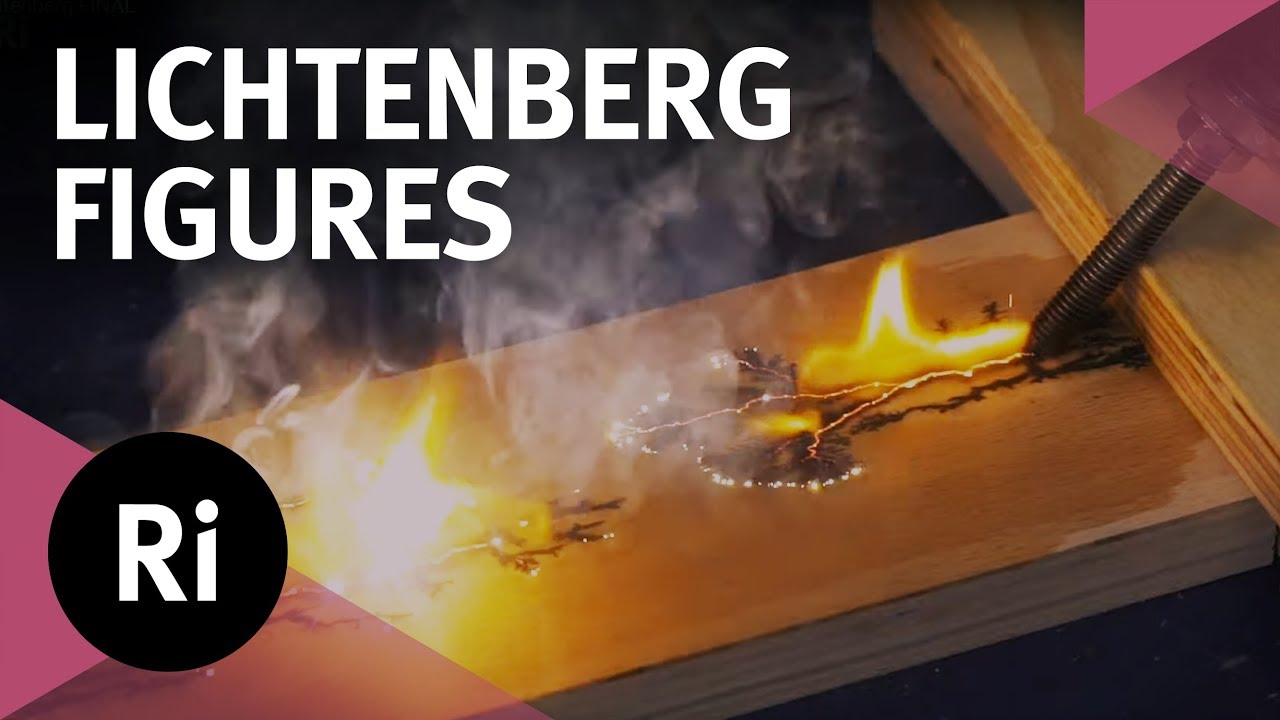The Royal Institution
Lichtenberg figures are formed by running a electricity across a non-conductive surface. Natasha explains the science behind them.
Subscribe for regular science videos: http://bit.ly/RiSubscRibe
Lichtenberg figures are beautiful branching patterns that can be burned into wood using electricity. The voltages and currents used are incredibly high so this should never be attempted at home.
Wood is a good insulator, which means that electricity won’t travel through it easily. But once the surface is brushed with a salt solution, this changes. The piece of wood can conduct electricity between the two bolts on either side.
The heat generated at the bolts evaporates the water and burns off a portion of the wood, leaving behind carbon in a form that conducts electricity. The carbon creates a pathway where current can flow, advancing in a conductive front until they meet the front coming from the other side, culminating in a bright flash.
—
A very special thank you to our Patreon supporters who help make these videos happen, especially:
Dave Ostler, David Lindo, Elizabeth Greasley, Greg Nagel, Ivan Korolev, Lester Su, Osian Gwyn Williams, Radu Tizu, Rebecca Pan, Robert Hillier, Roger Baker, Sergei Solovev and Will Knott.
—
The Ri is on Patreon: https://www.patreon.com/TheRoyalInstitution
and Twitter: http://twitter.com/ri_science
and Facebook: http://www.facebook.com/royalinstitution
and Tumblr: http://ri-science.tumblr.com/
Our editorial policy: http://www.rigb.org/home/editorial-policy
Subscribe for the latest science videos: http://bit.ly/RiNewsletter
Source




You're making me late for work. I gotta go
Burn!
Shame we won't be seeing a kit to do this in the RI shop 🃏
.
.
.
.
.
.
Apparently someone took this as a serious suggestion so I am adding this to point out that this was meant as a humourous comment
NOT MEANT AS A REAL SUGGESTION TO BE TAKEN SERIOUSLY !
Very interesting… You do realise, however, that there are certain people who will be driven to try this no matter how many times you say "don't do this at home…". Probably even more so, the more times you say it!
This is a very dangerous process. A gentleman a few blocks away from me electrocuted himself to death while making Lichtenberg Figures in his garage.
awesome thx. unscrewing my microwave right now, first huffing that sweet berrillium oxide tjan taking the parts to task (;
Is this somewhat similar to what happens when a person is hit by lightning? Because I've seen similar marks on lightning strike victims, the similarity is eerie.
Do not use a microwave transformer. Search for “bigclive lichtenberg” for the explanation why and what to use instead.
I remember making something similar to this (but nowhere near as dangerous lol) back in my 9th grade science class.
Insanely irresponsible putting this on to the internet despite all the warnings … ?
Whats the concentration of salt water?
If you dont want people doing it dont tell them where to get the parts. Make them figure it out themselves.
Great demonstration! The thing that drives the warning home to me is that in the 100+ RI videos I've watched that were filmed in the Faraday Lecture Theatre, I've rarely seen any empty seats, let along no audience at all. Which of course makes me want all the more to figure out how to do this safely;^)
Really appreciate when the reason for not doing X at home is explained, rather than just tempting the most reckless to attempt it.
Big Clive has a video showing you how to do this safely and without using the microwave oven transformer which has killed people.
Just like lightning woww
[Video Included Below]
I have tried using microwave transformers, but they burn too deep into the wood. They’re great, if your making figures on a thick (2” or 50mm) plank of wood, for use as a coffee table, but not very good for things like thin plywood, which you would hang on a wall. For that, I use a flyback transformer, and a high frequency ZVS driver. The output is about 35,000 volts, but the current is kept very low, for depth control and safety. I also substitute the salt, with baking soda. Either one is fine, but I don’t like having salt crystals in my LF’s. I’m an EE, by profession, and design high power RF transmission equipment for linear accelerators. I’m very familiar with working around high voltage. PLEASE don’t try this, if you don’t have experience with high voltage. It’s fun, but it’s not worth your life.
OK…. So here’s a video of me, making a Lichtenberg figure. This was one of my first, and I’ve refined my method since then. (I keep the wood wetter, I use better electrodes and slightly higher drive frequency.) The female voice is my wife, who is seeing it done, for the first time. I wish I had a more current video, but it’s the only one I have. My wife only took the video, so that she could show her friends the nerdy things that I do. 😂 Anyway… Enjoy!!! https://youtu.be/Zv3KbgIvCHk
Wundabaaaaar! Does it make difference if it is not full wood but just plywood? Anyway it is so interesting. More like this, please. 🙂
Electrizity…
Wow… Wonder if a F.A.R.T. neon sign driver would work? Much safer than a microwave transformer.
Plasma scars.
Good job
Omg how many times can you repeat don't try this at home and it will kill you in one video 🙁
Yes, after a while WE GET IT! (and as an electrician I can tell it's also slightly dramatic, it's not so bad unless you're just incredibly stupid)
I have a question why are we here using that part from microwave? It is just because to increase the voltage
Impressive experimet
Thanks for sharing 😀👍
√Thanks
Magnetrons in microweave ovens have not contained Beryllia for decades, just regular aluminia, as there is no need for the special properties of berylluim there, and the price is too high for it. However the magnetron still is dangerous because the aluminia can be hazardous as a powder. Plus the whole high voltage thing, and that it is a ground referenced high energy power source, and in general you do not get a second chance ever of having a shock, the first will be lethal. Same voltages and currents as the electric chair uses.
However other magnetrons in special applications do contain beryllia, but there you will always have a warning label on the equipment, both inside and outside it. Same for any specialised equipment that needs the heat transfer and insulating qualities of beryllia.
Oh my, please tell me you wore proper eye protection for this experiment. Those electric arcs are extremely bright and can burn your eyesight.
Thank goodness I didn't see this video when I was 15. Mother's microwave would've been toast !
"It's potentially live..". ?
I theorize that the burning occurs as the salt water solution evaporates a spark gap is formed from the previously burnt wood. I cannot prove the spark gap is forming, but a high speed camera and a good welding filter ought to be able to see if that is occuring.
My reasoning is an electric arc temperature is in the tens of thousands of degrees F (18K C) while resistive heating seems to top out in the mid thousands F (I don't currently have a source to back that up)
Wood carbarizes around a thousand degrees F (900C), but I suspect with how quickly lichtenberg figures form that the lower temperature of resistive heating just wouldn't work quickly enough.
I mostly work with imperial units, but I tried to make sure to include metric even though at such temperatures, and temperature difference, it feels like the distinction isn't really that important.
I've been making lichtenberg figures of and on for nearly a decade and sell a few every now and then, I stand a few feet away and keep a fire extinguisher handy, although, seeing that footswitch I realize it'd be really handy as a deadman type switch.
Thank you guys for the tutorial, I will try this tomorrow
Would you please carry on this experiment in an inert condition, result could be changed!?
Can we say Tattoo?
I already have one from my shoulder, down my back and to my hip so no need to do it on wood
The next time I see a microwave out on the streets, I am a 100% sure to take it apart and do this. It's an invitation. Don't worry, I know what I'm doing 😉
So at the end you have a mains short? Presumably there's a fuse somewhere in the circuit?
If you do this with DC current does the would the wood burn from one end to the other instead of coming from both ends and meeting in the middle?
what if you have already done it at home lol
Too late, already did this at home.
if you like this basic example of fractal wood burning check out my page of advanced fractal wood art
Just saw the video. What do I do now? I have already tried this at home before I saw this? How do I reverse my decision to have tried this at home as I do not know if I am part the limited group of experts who can try this at home, or just a pleb? Being a scientist can be very confusing. 😜🤞
my first electrical exp , done in grade 6 involved 20k volts
Electric mycelium
Named after Georg Christof Lichtenberg (1742 – 1799) who discovered them. Now try and pronounce the name properly!
Age restricted? AGE RESTRICTED?! Out of all the videos on youtube this one is age restricted, and it is done by a proffesional, while all others are done by amatures whom barely know what is happening.